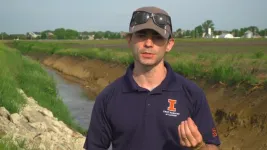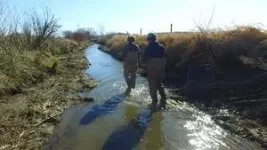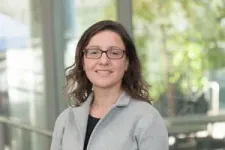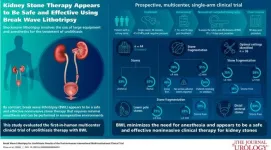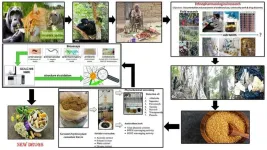(Press-News.org) As the world tries to mitigate agriculture’s effect on the environment, much of the story can be found in the soils, which stores and cycles nutrient elements of carbon, nitrogen, and phosphorus. Biogeochemistssuch as Andrew Margenot, Associate Director of the Agroecosystem Sustainability Center, are set to find answers, but for Margenot and other biogeochemistry experts who specialize in studying phosphorus cycling, the challenge is first being able to accurately measure where phosphorus has accumulated in the <100 years since humans began to increase the amount of the nutrient element in the biosphere.
Margenot, an Associate Professor of Soil Science in the Department of Crop Sciences at the University of Illinois Urbana-Champaign, and other phosphorus experts from around the world published a position or synthesis piece (as opposed to a research study) in Global Change Biology, to lay a roadmap to understand phosphorus cycling in the Anthropocene: the new geological era ushered in by human activities.
Other investigators with the project include Leo Condron, a Professor of Biochemistry at Lincoln University in New Zealand; Genevieve Metson, an Associate Professor in the Department of Geography and Environment at the University of West Ontario; Philip Haygarth, a Professor at the Lancaster University Environment Centre in the United Kingdom; and Jordan Wade, Soil Health Assessment Lead at the Syngenta Group, headquartered in Basel, Switzerland; along with Ph.D. student Prince Agyeman from the Czech Republic and research scientist Shengnan Zhou and postdoctoral researcher Suwei Xu from the Margenot research group at Illinois.
“The goal is to look at all possible ways to try to measure legacy phosphorus. This is a comprehensive one-stop shopper overview of where it makes sense to measure and where it makes sense to not worry about. In the process, we identify the priorities and non-priorities and provide a unified vision of what we should do going forward.”
The position paper focus on phosphorus in the “terrestrial aquatic continuum,” the interplay of water and soil that interact at varying scales of space and time“A big part of our paper was emphasizing uncertainty,” Margenot said. “This can be uncomfortable for policymakers because they have a need to make policy yesterday for tomorrow’s problems..”
It may take a century for legacy phosphorus already loaded into stream channels and build up o in the soil to fully disseminate to the waterways, so identifying how much and where this residual P is located is an important need
“When it comes to legacy phosphorus that will impact water for the next 100 years or more, we don’t even know the basics of where to start. However, there has to be a way to navigate the uncertainty: we don’t want to be too brash, but we also cannot wait 50 years to determine what to do either.”
In making recommendations for future phosphorus use, researchers can measure how much was added to the soil and how much was exported by biomass removal (e.g., harvest) or loss (e.g., leaching or erosion). Calculating the balance (what went in, minus what came out of a ‘system’ like a field, watershed or country) enables estimation of the quantify of residual P – a positive mass balance.
The position paper also provide several case studies of legacy P using the two oldest continuous agriculture test plots in the World, the Rothamsted Experiment in Harpenden, England founded in 1843, and the University of Illinois Morrow Plots founded in 1876. Among the discoveries was that the accumulated phosphorus is generally located in the top 12 inches of the soil, and is often in a different form than when it was added to the soil. This last part was a key finding of the paper.
“We typically add phosphorus in inorganic form as phosphate, which is readily soluble in in water and thus may be at a high risk for loss,” explains Margenot. “What we found is that even though we have a lot of phosphorus going on as phosphate, the amount that builds up doesn’t persist in soil in the soluble phosphate form. It transforms into forms associated with organic matter, iron, and calcium. So we can’t assume that the amount of phosphorus that was applied and not used (i.e., residual phosphorus), is there for the taking by the crop or potential loss to water.”
In addition to comprehensively evaluating the problem, the consortium made several recommendations.
1) Researchers need to be better at validating estimates. “Oftentimes we don’t measure the small input or the output amounts of phosphorus. Over time those gaps in the measurements amplify uncertainty,” Margenot says.
2) Scientists often don’t have sufficient information to form decent estimates.The group suggests an initiative where the private sector (e.g., soil testing labs) could work with researchers to make use of existing datasets.
3) There needs to be a uniform method of measuring the data. “In a lot of cases, basic measurements basically haven’t been taken,” Margenot says. “We need to couple complementary methods that are individually not great, but in combination are quite strong. While it can be overwhelming to figure out where the P has built up over the last 70 years, I think the important thing is to identify where it matters for different reasons of agronomic utilization and water quality impairment.”
4) There needs to be an effort to discover the hot spots of legacy P so that resources could be prioritized to decrease the negative impacts of water quality. Margenot’s group is already doing that in Illinois. “We don’t need to map the entire state,” Margenot says. “We know where there is a priority watershed because the USGS is measuring this.”
The challenge according to the paper is to convince researchers and funders to allocate resources to provide data that will make a difference. “To get that last 5 percent of the data will cost you half of what it takes for other 95% of the data,” Margenot notes.
The challenge for policymakers, according to Margenot, will be to explain that because the measurements of legacy P are estimates at this point, they should see the data as a living document. “The policies have to be plastic,” he says.
“The global phosphorus has been more perturbed by human activities than nitrogen,” Margenot notes. “We’ve about doubled the amount of nitrogen in circulation in the biosphere, but we have quadrupled it for phosphorus.”
END
Biogeochemistry scientists from around the world, led by the ASC's Margenot, publish position paper on tackling “hidden” phosphorus
Andrew Margenot led some of the top biogeochemists from around the world in synthesizing recommendations for measuring phosphorus accumulation in the biosphere
2024-09-11
ELSE PRESS RELEASES FROM THIS DATE:
New, rare type of small cell lung cancer identified by MSK research team
2024-09-11
A team of doctors and researchers at Memorial Sloan Kettering Cancer Center (MSK) have identified a new, rare type of small cell lung cancer that primarily affects younger people who have never smoked.
Their findings, which include a detailed analysis of the clinical and genetic features of the disease, also highlight vulnerabilities that could help doctors make better treatment decisions for people diagnosed with it.
“It’s not every day you identify a new subtype of cancer,” says Natasha Rekhtman, MD, PhD, an MSK pathologist specializing in lung cancer and the first author of a paper published August 26 in Cancer Discovery presenting ...
Light pollution a new Alzheimer’s risk factor
2024-09-11
Outdoor light at night could be a significant risk factor in Alzheimer’s disease, according to new research from Rush.
While light pollution is associated with increased risk of some disorders and diseases, this is the first time it had been associated with Alzheimer’s disease.
The study was conducted at Rush University System for Health and published in Frontiers in Neuroscience.
“Our research shows that there is an association in the U.S. between Alzheimer’s disease prevalence and exposure to light at night, particularly in those under the age of 65,” said lead investigator, Robin Voigt-Zuwala, PhD, an associate professor at Rush. “Nightly ...
Clovis people used Great Lakes camp annually 13,000 years ago
2024-09-11
Graphics // Photos
The earliest humans to settle the Great Lakes region likely returned to a campsite in southwest Michigan for several years in a row, according to a University of Michigan study.
Until recently, there was no evidence that people from the Clovis period had settled the Great Lakes region. Clovis people appeared in North America about 13,000 years ago, during the geologic epoch called the Pleistocene. During the Pleistocene, sheets of glaciers covered much of the world, including Michigan, making the land inhospitable for human settlers. But a 2021 U-M study confirmed that Clovis people built ...
Can having a stroke change your sleep?
2024-09-11
EMBARGOED FOR RELEASE UNTIL 4 P.M. ET, WEDNESDAY, SEPTEMBER 11, 2024
MINNEAPOLIS – People who have had a stroke may be more likely to sleep too much or too little compared to those without prior stroke, according to a study published in the September 11, 2024, online issue of Neurology®, the medical journal of the American Academy of Neurology. The study does not prove that stroke causes abnormal sleep; it only shows an association.
“Sleeping the right amount is considered essential for ideal brain and heart health,” said study author Sara Hassani, ...
Microscale robot folds into 3D shapes and crawls
2024-09-11
ITHACA, N.Y. – Cornell University researchers have created microscale robots less than 1 millimeter in size that are printed as a 2D hexagonal “metasheet” but, with a jolt of electricity, morph into preprogrammed 3D shapes and crawl.
The robot’s versatility is due to a novel design based on kirigami, a cousin of origami, in which slices in the material enable it to fold, expand and locomote.
The team’s paper, “Electronically Configurable Microscopic Metasheet Robots,” published Sept. 11 in Nature Materials. The paper’s co-lead authors are postdoctoral ...
New noninvasive technique provides effective treatment for urinary stones
2024-09-11
September 11, 2024 — A noninvasive ultrasound technology called Break Wave™ lithotripsy (BWL) offers a safe and effective new option for treatment of urinary stones, reports a clinical trial in the October issue of The Journal of Urology®, an Official Journal of the American Urological Association (AUA). The journal is published in the Lippincott portfolio by Wolters Kluwer.
"In this initial experience, BWL provided a high treatment success rate, using a portable technology that can be used in a range of settings, without the need for anesthesia" comments lead ...
Researchers uncover new infection-fighting molecules through “molecular de-extinction”
2024-09-11
A new study led by Cesar de la Fuente, PhD, Presidential Assistant Professor of Psychiatry, Microbiology, Chemistry, Chemical and Biomolecular Engineering, and Bioengineering at the University of Pennsylvania, has uncovered sequences for infection-fighting molecules in the genomic data of extinct species. This most recent study in the emerging field of “molecular de-extinction”, pioneered by Prof. de la Fuente, offers the potential to develop new antimicrobial treatments in the fight against rising antibiotic resistance.
The study, published in Cell Reports Physical Science, analyzed genomic data from the extinct moa, a flightless bird from New Zealand, ...
Keeping mold out of future space stations
2024-09-11
COLUMBUS, Ohio – Mold can survive the harshest of environments, so to stop harmful spores from growing on future space stations, a new study suggests a novel way to prevent its spread.
Researchers created a predictive approach for modeling unintended microbial growth in critical spaces and applied it to life on the International Space Station.
An analysis of dust samples obtained from the space station found that repeated elevated humidity exposures for even a short time can lead to rapid microbial growth and composition changes in dust that make it easier for microbes, ...
"It feels like I'm moving my own hand". A research team from the Scuola Superiore Sant'Anna in Pisa has developed the prosthesis of the future, the first in the world with magnetic control
2024-09-11
Pisa, 11 september. It is the first magnetically controlled prosthetic hand, that allows amputees to reproduce all movements simply by thinking and to control the force applied when grasping fragile objects. No wires, no electrical connection, only magnets and muscles to control the movements of the fingers and enable everyday activities such as opening a jar, using a screwdriver, picking up a coin.
A research team from the BioRobotics Institute of the Scuola Superiore Sant'Anna in Pisa, coordinated by Prof. Christian Cipriani, has ...
Self-medicating gorillas and traditional healers provide clues for new drug discovery
2024-09-11
Four plants consumed by wild gorillas in Gabon and used by local communities in traditional medicine show antibacterial and antioxidant properties, find Leresche Even Doneilly Oyaba Yinda from the Interdisciplinary Medical Research Center of Franceville in Gabon and colleagues in a new study publishing September 11 in the open-access journal PLOS ONE.
Wild great apes often consume medicinal plants that can treat their ailments. The same plants are often used by local people in traditional medicine.
To investigate, researchers observed the behavior of western lowland gorillas (Gorilla gorilla ...
LAST 30 PRESS RELEASES:
CFRI special issue call for papers: New Frontiers in Sustainable Finance
HKU Engineering scholar demonstrates the smallest all-printed infrared photodetectors to date
Precision empowerment for brain "eavesdropping": CAS team develops triple-electrode integrated functional electrode for simultaneous monitoring of neural signals and chemical transmitters during sleep
Single-capillary endothelial dysfunction resolved by optoacoustic mesoscopy
HKU three research projects named among ‘Top 10 Innovation & Technology News in Hong Kong 2025’ showcasing excellence in research and technology transfer
NLRSeek: A reannotation-based pipeline for mining missing NLR genes in sequenced genomes
A strand and whole genome duplication–aware collinear gene identification tool
Light storage in light cages: A revolutionary approach to on-chip quantum memories
Point spread function decoupling in computational fluorescence microscopy
BacPhase: Long-insert paired-end sequencing for bin marker construction and genome phasing
GmWOX1 regulates the mediolateral polarity of compound leaves in soybean
ChargeFabrica: An open-source simulation tool that aims to accelerate search for high performance perovskite solar cells
High levels of ADAR overexpression induce abundant and stochastic off-target RNA editing in rice protoplasts
On-demand upgraded recycling of polyethylene and construction of sustainable multifunctional materials based on the "LEGO" strategy
New "Stomata in-sight" system allows scientists to watch plants breathe in real-time
Anorexia nervosa may result in long-term skeletal muscle impairment
Narrative-based performance reviews deemed fairest by employees
New insights reveal how advanced oxidation can tackle emerging water pollutants
New review shows how biomass can deliver low-carbon gaseous fuels at scale
Climate change is quietly rewriting the world’s nitrogen cycle, with high stakes for food and the environment
Study finds SGLT-2 inhibitors linked to lower risk of diabetic foot nerve damage
Microbes may hold the key to brain evolution
Study examines how the last two respiratory pandemics rapidly spread through cities
Gender stereotypes reflect the division of labor between women and men across nations
Orthopedics can play critical role in identifying intimate partner violence
Worms as particle sweepers
Second spider-parasitic mite described in Brazil
January 2026 issues of APA journals feature new research on autism, pediatric anxiety, psychedelic therapy, suicide prevention and more
Private equity acquired more than 500 autism centers over the past decade, new study shows
New cervical cancer screening guidelines from the US Department of Health and Human Services
[Press-News.org] Biogeochemistry scientists from around the world, led by the ASC's Margenot, publish position paper on tackling “hidden” phosphorusAndrew Margenot led some of the top biogeochemists from around the world in synthesizing recommendations for measuring phosphorus accumulation in the biosphere
